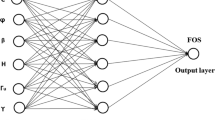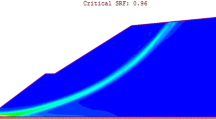Abstract
In this study, the calculability of slope stability using the artificial neural networks (ANN) method was examined. Initially, 100 synthetic slope models were created to be used in calculations and the factors of safety of these slopes were calculated by a conventional stability calculation method using slope parameters. Then, factors of safety were calculated by through ANN method. 80 of the datasets from the generated data were used for training while 20 were used for testing in these calculations with the ANN method. In both conventional calculation of stability and the ANN method, input parameters included slope height, height of the water level, slope angle, unit weight, cohesion and angle of internal friction, while the output parameter was factor of safety (SF). A good level of consistency was obtained between the SFs calculated through the conventional method and the ANN method. Furthermore, SFs were calculated separately via the ANN method by assigning range values to unit weight, cohesion and angle of internal friction from amongst the parameters that affect SF for Giresun landslides (Eastern Turkey). The data obtained in this scope revealed that cohesion was the parameter with the highest level of effect on SF. Consequently, it was established that the factors of safety of slopes could be calculated by means of the ANN method in a rapid and convenient manner, the effects of slope parameters on the factors of safety in landslide were examined and the factors of safety for Giresun landslides were calculated through the ANN method.







Similar content being viewed by others
References
Bayındır R, Sagiroğlu S, Colak I (2009) An intelligent power factor corrector for power system using artificial neural networks. Electr Power Syst Res 79:152–160
Beer G, Watson JO (1992) Introduction to finite and boundary element methods for engineers. Wiley, Chichester
Bishop AW (1955) The use of the slip circle in the stability analysis of slopes. Geotech Great Br 5(1):7–17
Brady BHG (1979) A direct formulation of the boundary element method of stress analysis for complete plane strain. Int J Rock Mech Min Sci 16(4):235–244
Brady BHG (1987) Boundary element and linked methods for underground excavation design. In: Brown ET (ed) Analytical and computational methods in engineering rock mechanics. Allen and Unwin, London, pp 164–204
Chen Z, Maun JC (2000) Artificial neural network approach to single-ended fault locator for transmission lines, power systems. IEEE Trans Power Syst 15(1):370–375
Cordes E, Fehrenbacher G, Schutz R, Sprunck M, Hahn K, Hofmann R, Biersack JP, Wahl W (1998) Nuclear science. IEEE Trans Nucl Sci 45(3):1464–1469
Cundall PA (1971) A computer model for simulating progressive, large scale movements in blocky rock systems, in Rock Fracture. In: Proceedings International Symposium on Rock Mechanics. Nancy, France
Cundall PA (1987) Distinct element models of rock and soil structure. In: Brown ET (ed) Analytical an computational methods in engineering rock mechanics. Allen and Unwin, London, pp 129–163
Demuth H, Beale M (2000) Neural network toolbox for use with matlab. User’s guide 4 The MathWorks
Detournay C, Hart R (1999) FLAC and numerical modeling in geomechanics. In: Hart R (ed) Proceedings, Conference, Minneapolis. Balkema, Rotterdam
Domenech C, Wehr T (2011) Use of artificial neural networks to retrieve toa sw radiative fluxes for the earthcare mission. IEEE Trans Geosci Remote Sens 49(6):1839–1849
Fellenius W (1927) Erdstatishe berechmungen mit reibungund kohesion. Ernest Verlag, Berlin
Güven İH (1993) Doğu Pontidlerin 1/25 000 ölçekli jeolojisi ve komplikasyonu. MTA Dergisi Yayınları Ankara, Turkey (in Turkish)
Hart RD, Detournay C, Cundall PA (2008) Continuum and distinct element modeling in geo-engineering. In: Cundall PA (ed) Proceedings First FLAC/DEM Symposium 25 (27August, Minneapolis, USA). Itasca Consulting Group Inc., Minneapolis, p 698
Hebb DO (1949) The organization of behavior: a neuropsychological theory. Wiley, New York
Itasca (2011) FLAC ver 6.0, FLAC3D ver 4.0, FLAC/Slope ver 6.0, UDEC ver 5.0 & 3DE Ver 4.1. Itasca Consulting Group Inc., Minneapolis
Jain S, Ali MM (2006) Estimation of sound speed profiles using artificial neural networks. Geosci Remote Sens Lett IEEE 3(4):467–470
Janbu N (1954) Application of composite slip circles for stability analysis. Proc Eur Conf Stab Earth Slopes 4:43–49
Janbu N (1973) Slope stability computations. In: Embankment Dam Engineering, Casagrande memorial volume. Wiley, New York
Janbu N, Bjerrum L, Kjaernsli B (1956) Veileding ved losning av fundamentering-soppgaver. Publication no. 16, Norwegian Geotechnical Institute
Jemei S, Hissel D, Pera MC, Kauffmann JM (2008) A new modeling approach of embedded fuel-cell power generators based on artificial neural network. Ind Electron IEEE Trans 55(1):437–447
Lou SLA, Lin JS, Freedman MT, Chien MV, Mun SK (1995) Artificial convolution neural network techniques and applications for lung nodule detection. Med Imaging IEEE Trans 14(4):711–718
Ming Z (2011) A neural network application in predicting slope stability. In: International Conference on Electric Information and Control Engineering (ICEICE)
Minnix JI, McVey ES, Inigo RM (1992) A multilayered self-organizing artificial neural network for invariant pattern recognition. Knowl Data Eng IEEE Trans 4(2):162–167
Morgenstern NR, Price VE (1965) The analysis of the stability of general slip surfaces. Geotechnique 15(1):79–93
Nalina P, Meenambal T, Sathyanarayan-Sridhar R (2014) Slope stability analysis of Kallar-Coonoor hill road stretch of the nilgiris. J Comput Sci 10(7):1107–1114
Ostlin E, Zepernick H, Suzuki H, Macrocell P (2010) Path-loss prediction using artificial neural networks. Veh Technol IEEE Trans 59(6):2734–2747
Pradhan B, Lee S (2009) Landslide risk analysis using artificial neural network model focusing on different training sites. Int J Phys Sci 4:001–015
Sağıroğlu Ş, Çolak İ, Bayındır R (2006) Power factor correction technique based on artificial neural networks. Energy Convers Manag 47(18–19):3204–3215
Sakellariou MG, Ferentinou MD (2005) A study of slope stability prediction using neural networks. Geotech Geol Eng 23:419–445
Sarma SK (1973) Stability analysis of embankments and slopes. Geotechnique 23(3):423–433
Sarma SK (1979) Stability analysis of embankments and slopes. ASCE J Geotech Eng Div 105:1511–1524
Spencer E (1967) A method of analysis of the stability of embankments assuming parallel inter-slice forces. Geotechnique 17:2–26
Taylor DW (1937) Stability of Earth Slopes. Control Soil Mechanics for the Society of Civil Engineers, Boston
Tolon M (2007) Artificial neural network approaches for slope stability. Dissertation, ITU Institute of Science and Technology, Istanbul
Venkatesan R, Balamurugan B (2001) A real-time hardware fault detector using an artificial neural network for distance protection. Power Deliv IEEE Trans 16(1):75–82
Wang HB, Xu WY, Xu RC (2005) Slope stability evaluation using back propagation neural networks. Eng Geol 80:302–315
Zhou K, Chen Z (2009) Stability prediction of tailing dam slope based on neural network pattern recognition. In: Second International Conference on Environmental and Computer Science. Dubai
Zhou ZH, Jiang Y (2003) Medical diagnosis with C4.5 rule preceded by artificial neural network ensemble. Inf Technol Biomed IEEE Trans 7(1):37–42
Zhu Y, Ding X, Li Z, Zhou S (2010) Analysis on uranic slope stability based on neural network. Int Forum Inf Technol Appl, China
Acknowledgments
This research was supported by Karadeniz Technical University research funding (No: 8781).
Author information
Authors and Affiliations
Corresponding author
Rights and permissions
About this article
Cite this article
Gelisli, K., Kaya, T. & Babacan, A.E. Assessing the factor of safety using an artificial neural network: case studies on landslides in Giresun, Turkey. Environ Earth Sci 73, 8639–8646 (2015). https://doi.org/10.1007/s12665-015-4027-1
Received:
Accepted:
Published:
Issue Date:
DOI: https://doi.org/10.1007/s12665-015-4027-1




